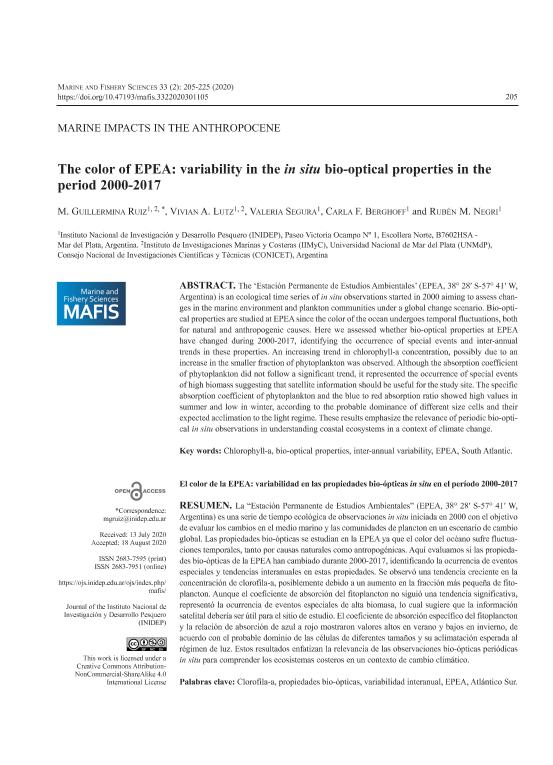Artículo
La 'Estación Permanente de Estudios Ambientales' (EPEA, 38° 28′ S-57° 41′ W, Argentina) es una serie temporal ecológica de observaciones in situ iniciada en 2000 con el objetivo de evaluar los cambios en el medio marino y las comunidades de plancton bajo un escenario de cambio global. En EPEA se estudian las propiedades bioópticas ya que el color del océano sufre fluctuaciones temporales, tanto por causas naturales como antropogénicas. Aquí evaluamos si las propiedades bioópticas en EPEA han cambiado durante 2000-2017, identificando la ocurrencia de eventos especiales y tendencias interanuales en estas propiedades. Se observó una tendencia creciente en la concentración de clorofila-a, posiblemente debido a un aumento en la fracción más pequeña de fitoplancton. Aunque el coeficiente de absorción del fitoplancton no siguió una tendencia significativa, representó la ocurrencia de eventos especiales de alta biomasa, lo que sugiere que la información satelital debería ser útil para el sitio de estudio. El coeficiente de absorción específica del fitoplancton y la relación de absorción azul a rojo mostraron valores altos en verano y bajos en invierno, de acuerdo con la probable dominancia de células de diferentes tamaños y su esperada aclimatación al régimen lumínico. Estos resultados enfatizan la relevancia de las observaciones bioópticas in situ periódicas para comprender los ecosistemas costeros en un contexto de cambio climático. The Estación Permanente de Estudios Ambientales (EPEA, 38°28´S 57°41´W, Argentina) is an ecological time series of in situ observations started in 2000 aiming to assess changes in the marine environment and plankton communities under a global change scenario. Bio-optical properties are studied at EPEA since the color of the ocean undergoes temporal fluctuations, both for natural and anthropogenic causes. Here we assessed whether bio-optical properties at EPEA have changed during 2000-2017, identifying the occurrence of special events and inter-annual trends in these properties. An increasing trend in chlorophyll a concentration, possibly due to an increase in the smaller fraction of phytoplankton was observed. Although the absorption coefficient of phytoplankton did not follow a significant trend, it represented the occurrence of special events of high biomass suggests that satellite information should be useful for the study site. The specific absorption coefficient of phytoplankton and the blue to red absorption ratio showed high values in summer and low in winter, according to the probable dominance of different size cells and their expected acclimation to the light regime. These results emphasize the relevance of periodic bio-optical in situ observations in understanding coastal ecosystems in a context of climate change.
The color of EPEA: Variability in the in situ bio-optical properties in the period 2000-2017
Ruiz, María Guillermina ; Lutz, Vivian Alicia
; Lutz, Vivian Alicia ; Segura, Valeria; Berghoff, Carla Florencia; Negri, Rubén
; Segura, Valeria; Berghoff, Carla Florencia; Negri, Rubén
 ; Lutz, Vivian Alicia
; Lutz, Vivian Alicia ; Segura, Valeria; Berghoff, Carla Florencia; Negri, Rubén
; Segura, Valeria; Berghoff, Carla Florencia; Negri, Rubén
Fecha de publicación:
12/2020
Editorial:
Instituto de Investigación y Desarrollo Pesquero
Revista:
Marine and Fishery Sciences
ISSN:
2683-7595
e-ISSN:
2683-7951
Idioma:
Inglés
Tipo de recurso:
Artículo publicado
Clasificación temática:
Resumen
Archivos asociados
Licencia
Identificadores
Colecciones
Articulos(IIMYC)
Articulos de INSTITUTO DE INVESTIGACIONES MARINAS Y COSTERAS
Articulos de INSTITUTO DE INVESTIGACIONES MARINAS Y COSTERAS
Citación
Ruiz, María Guillermina; Lutz, Vivian Alicia; Segura, Valeria; Berghoff, Carla Florencia; Negri, Rubén; The color of EPEA: Variability in the in situ bio-optical properties in the period 2000-2017; Instituto de Investigación y Desarrollo Pesquero; Marine and Fishery Sciences; 33; 2; 12-2020; 205-225
Compartir
Altmétricas



